1lumen selects and reviews products personally. We may earn affiliate commissions through our links, which help support our testing.
Mijomi J81 review: flashlight test

Mijomi J81 specifications
| Brand & Model | Mijomi J81 |
|---|---|
| LED | Osram P9 |
| Lumens | 1300 Lumens |
| Beam intensity | not reported |
| Battery config. | 1*18650, 2*CR123A |
| Onboard charging | USB-C |
| Modes | 5 |
| Blinkies | Strobe, SOS |
| Reflector | Smooth |
| Waterproof | IPX68 |
| Review publication date | September 2022 |
Introduction:
Mijomi is a relatively new manufacturer with little online presence and seemingly only one model, the J81. This is a dual switch tactical light with an Osram P9 emitter and a claim of 1300 lumens with the included 18650 battery. There’s very little information about the company or light online aside from the Amazon listing, so let’s find out what it’s like.
Package quality.
Mijomi provided this light in a nice looking box that would be right at home on a shelf in a brick and mortar store. On the font is a glossy photo of the J81 itself, while the rear has a diagram of the light and specs. One side of the package has information about blinky modes, and the other has Mijomi’s site and social media handles, though the site doesn’t work and the Facebook/Instagram pages are rarely updated.
The light is held in a plastic insert in the box, with the accessories slotted in around it. The entirety of the box contains:
- Mijomi J81
- Unbranded 2600mAh 18650 battery, inside the light
- Two o-rings in a plastic zip top bag
- Lanyard
- Clip, attached to the light
- USB A to USB C cable
- Belt holster
- Manual
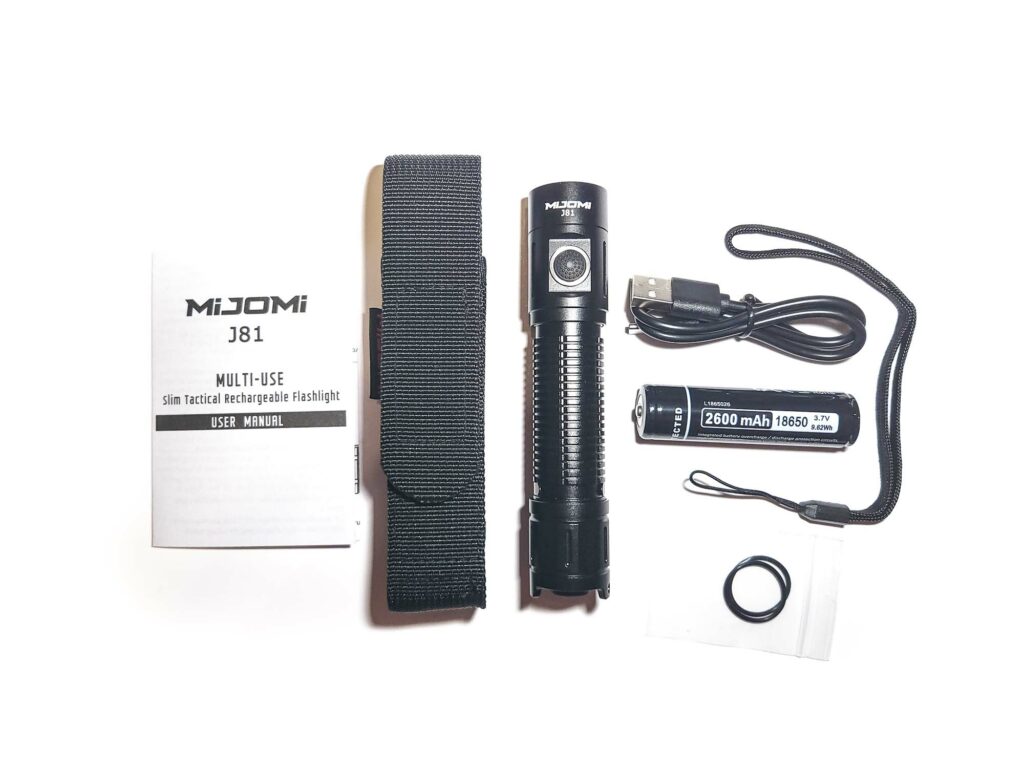
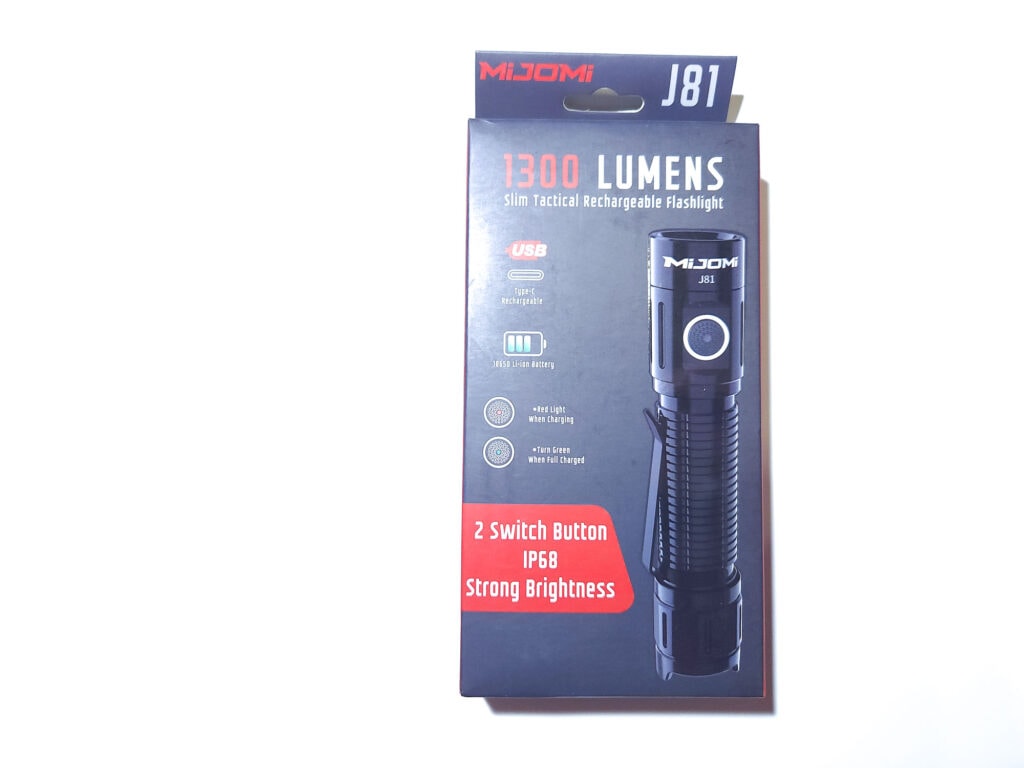
Flashlight in use
While this is a dual switch light, it leans heavily towards the tactical side since the electronic side switch only switches modes and cannot turn the light on or off, and the tail has a mechanical, forward clicky switch. This lends itself to being carried in the overhand position, since the tail is the only activation method. The cigar hold is also ok, but again, this is where it proves to be more tactical in nature. If you want to change modes, you will have to change your grip to the more standard style of holding a flashlight, or use both hands. Additionally, the modes only advance in order and there are no shortcuts, so you’ll have to cycle through all the brightness levels to go down one step.
Holding the light with your full hand in either direction is easy thanks to a combination of knurling, and the tube being thinner than the tail (and head), it gives your fingers something to brace against in the cigar grip.
The light will definitely not roll around if you set it down due to the clip, but the tail cap also has six flat sides. These do not take up the whole of the tail cap, but are surrounded by curved sections with grooves in them, but are definitely large enough to keep it stationary. The grooves do not appear to be designed for tritium vials.
The head has similar but longer grooves, and opposite the button is the USB C charging port. Above the button is the flashlight branding, and on the reverse, above the charging port, is some regulatory information.
The tail switch has a somewhat weird feel to it and the boot has thick walls, so when you’re pressing down on it, you’re compressing the walls as well. But it travels nicely and there are no problems with keeping it depressed halfway for momentary activation. One thing I noticed, though, is that there’s a bit of lag between when you press the tail switch and when the light fully powers on when on high (level 5). I don’t know if this is a switch or driver issue, but it appears that the light quickly fades in or ramps up to maximum power.
The side switch is in a recessed cutout on the head, though it still sticks out. The boot is covered in small raised dots, giving it an easy-to-locate feel, and there is a clear center where the indicator light resides. The indicator light will come on for 3 seconds every time the mode is changed.
The clip will hold the light tightly, though it’s over the knurling, so this could have a cheese grater effect on your pocket, or wherever you hang it. The arms of the clip slide easily and while it didn’t happen to me in this testing period, I feel like the clip could easily pop off if it got snagged on something.
One side of the tail has two eyelets through which you can weave the lanyard, which is fairly standard as far as lanyards go. While the light can tail stand, the posts on the tail are small; I would say they comprise maybe 1/3 of the circumference of the tail, which makes it unstable. A small irregularity in the surface you’re setting it on or a light bump could easily knock it over.
The included holster is made entirely from webbing, having no elasticity on any side, and has a hook and loop closure. On the back is a belt loop that is sewn in, so it cannot be attached to a webbing system without additional hardware.
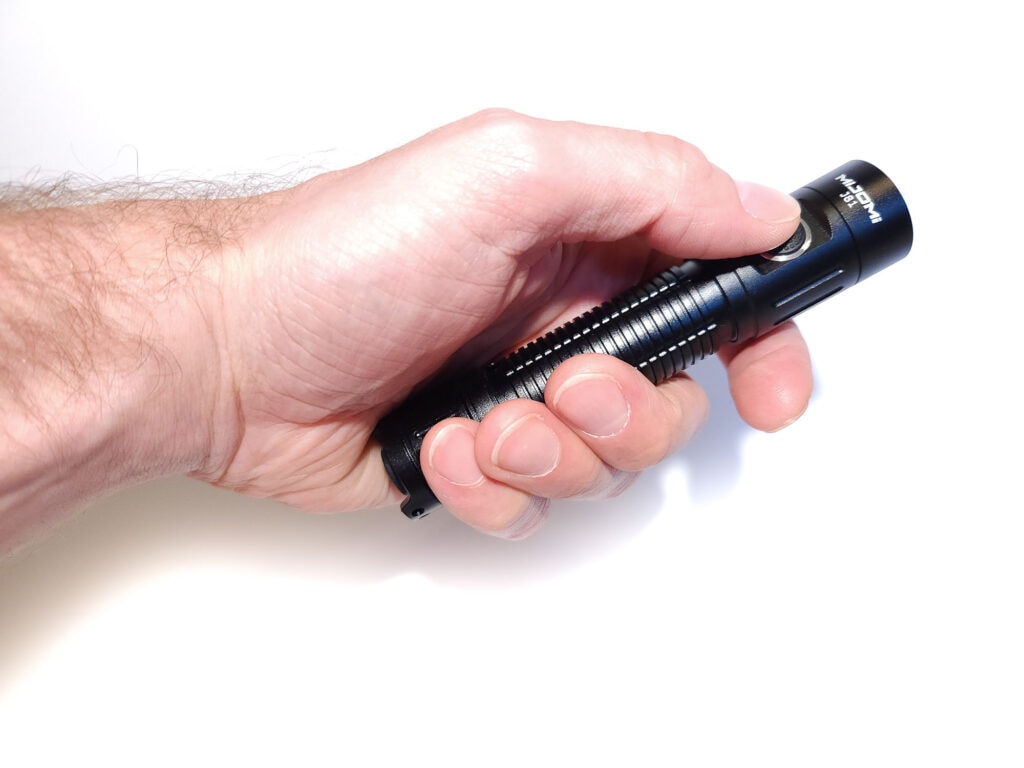
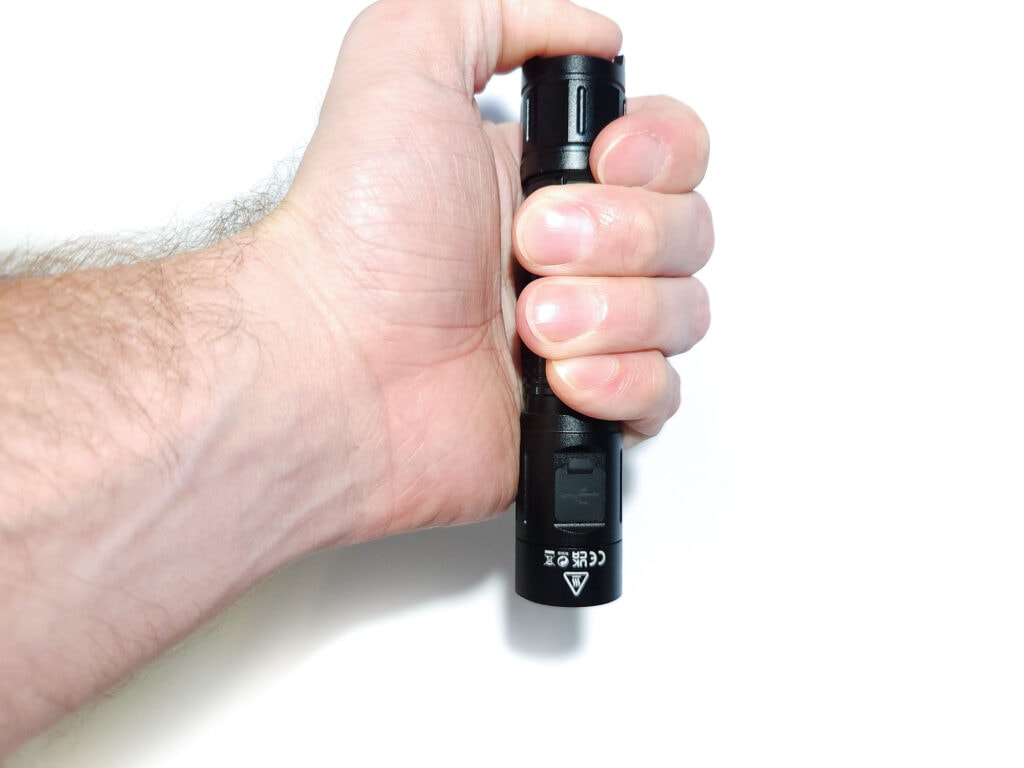
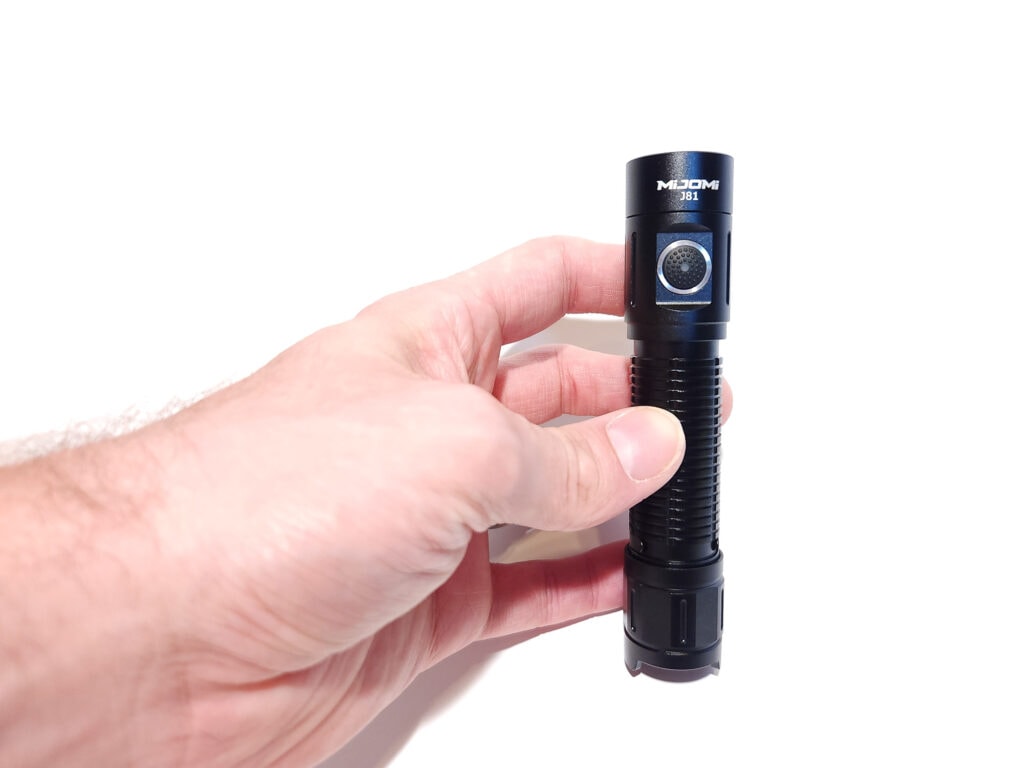
Build Quality, and Warranty
The anodization on the Mijomi J81 has a black satin finish which appears to be very good quality, though mine did come with a tiny knick in it. It only comes in aluminum, as it’s not a luxury light.
The head and tail both screw on over the body tube, though the head is glued on and not easily removed. The tail cap is tight to screw on or off and while there is some lube on the threads, you do get a gritty, grinding feeling when tightening or loosening it. The threads are anodized, allowing for mechanical lock out.
Aside from the features mentioned in the previous section, the main body has some interesting knurling. Horizontal grooves are interspersed with vertical cuts, though while the horizontal ones are squared, the vertical ones are curved, almost hemispherical.
On the inside, there are springs on both the driver and tail which hold the included battery securely in place. Since it’s built around a protected, button top battery, a flat top 18650 will connect, but can disconnect with a sharp hit.
All the parts fit together well, and there are no rattles if shaken (with the included battery).
The manual states Mijomi offers a two year warranty, but that full details are available on their website, mijomiworld.com, however, the site doesn’t work at the time of this writing. Since it’s only available for sale on Amazon, you may be able to contact Mijomi that way as well.

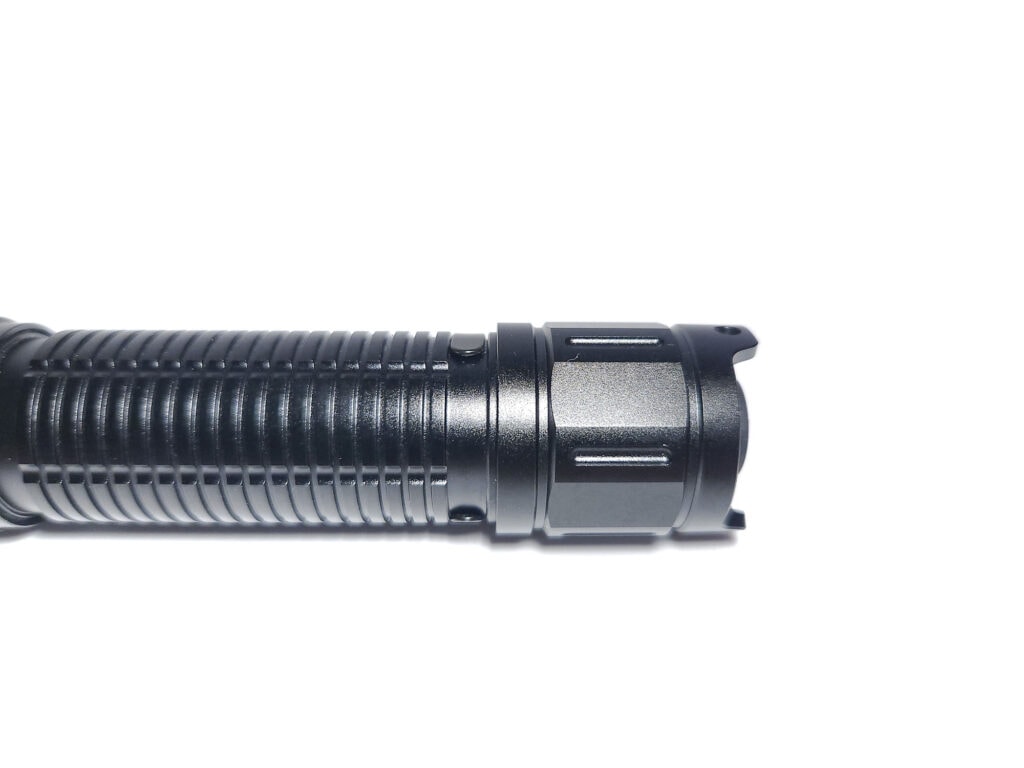
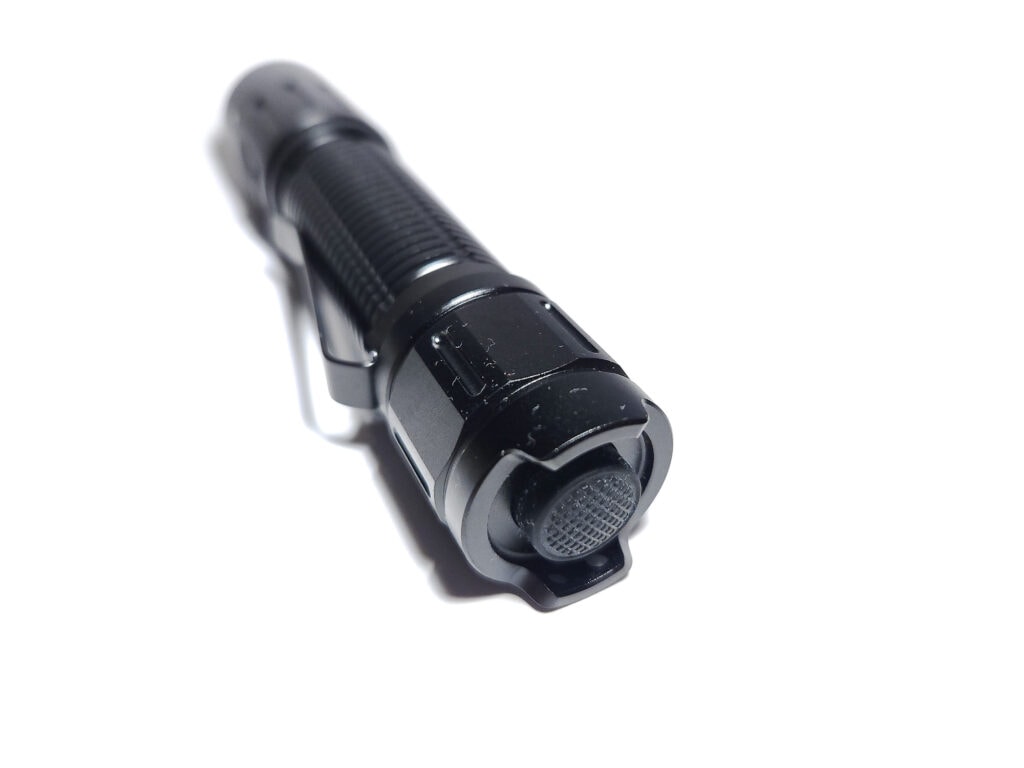
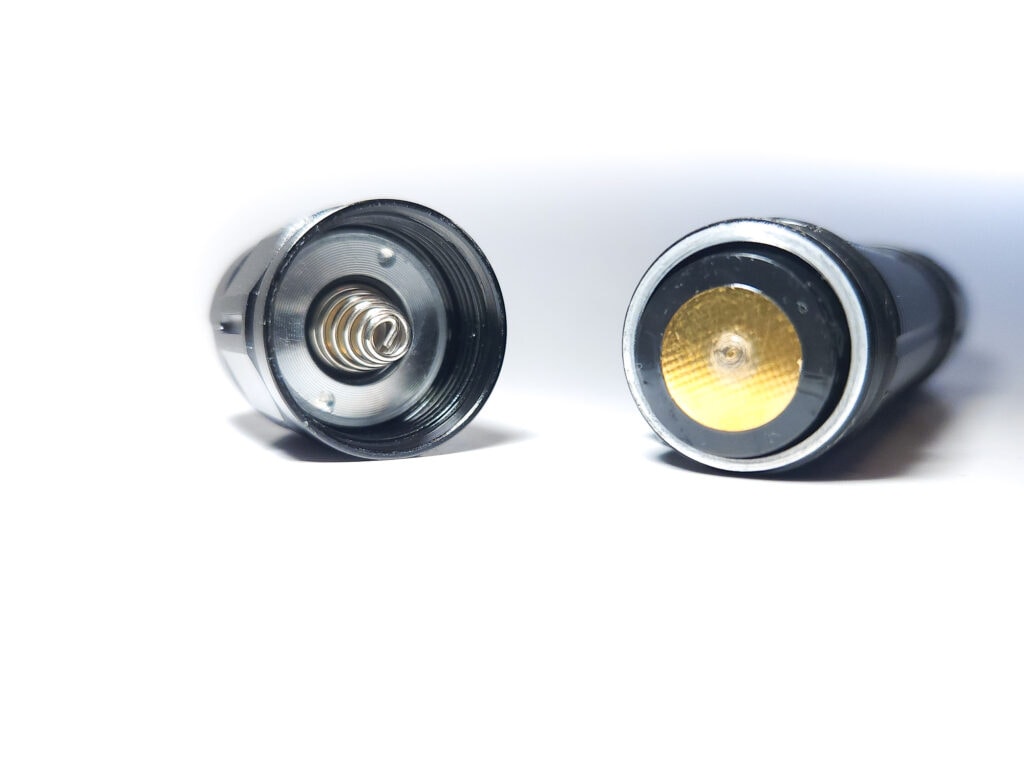
LED, Lens, Bezel, Beam, and Reflector
For the J81, Mijomi used the Osram P9 as the emitter. P9 is actually a nickname of sorts, and what I believe they’re referring to is the Osram Osconiq P GW PISTA1.PM, a 3W, 3737-sized LED.
Mijomi doesn’t specify the temperature, but I measured it to be 5500-5700K. As with many domed emitters, it suffers from some tint shift, going from a yellow hotspot to blue corona around the whitish spill, with the effect getting more intense as brightness increases. On lower brightness, however, it is very green.
The emitter is situated at the center of a smooth reflector to maximize throw behind a glass lens and capped off by a smooth bezel. The last part there being somewhat uncharacteristic of a tactical light. Usually they have at least small crenulations if not a full-on strike bezel.
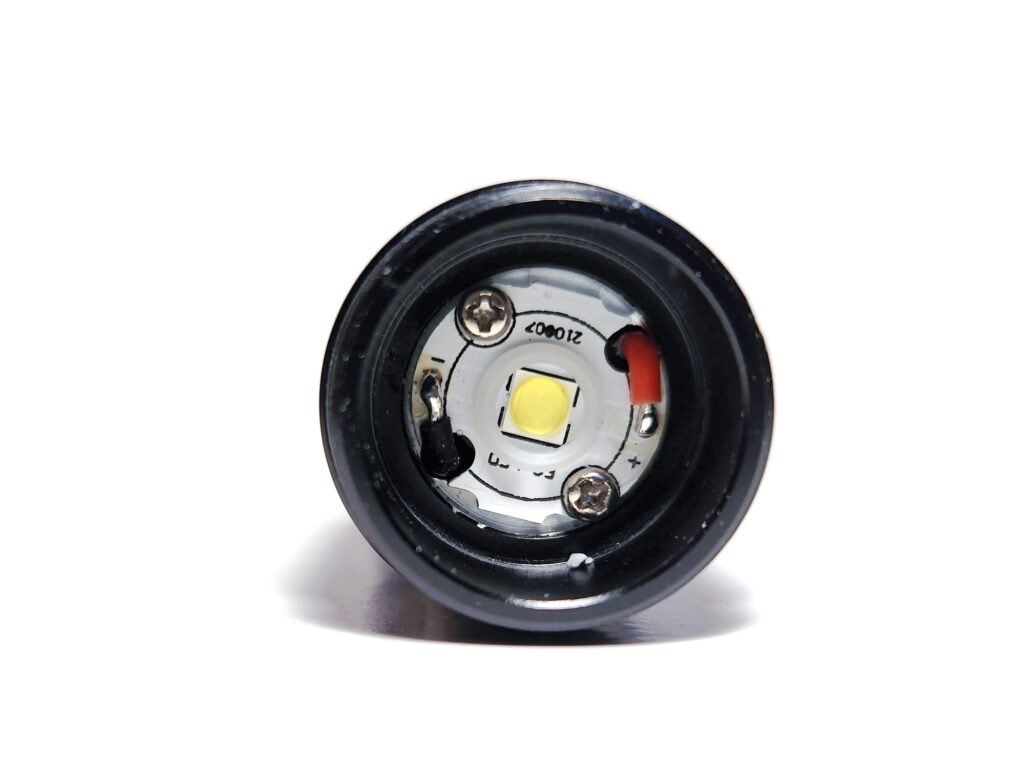
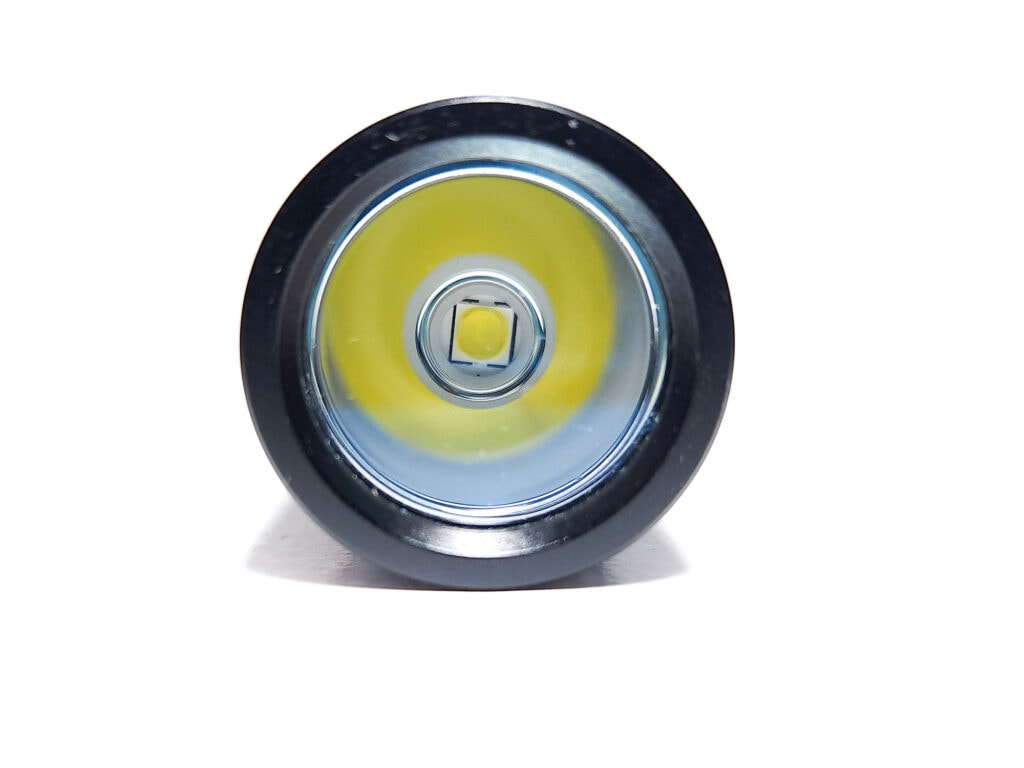
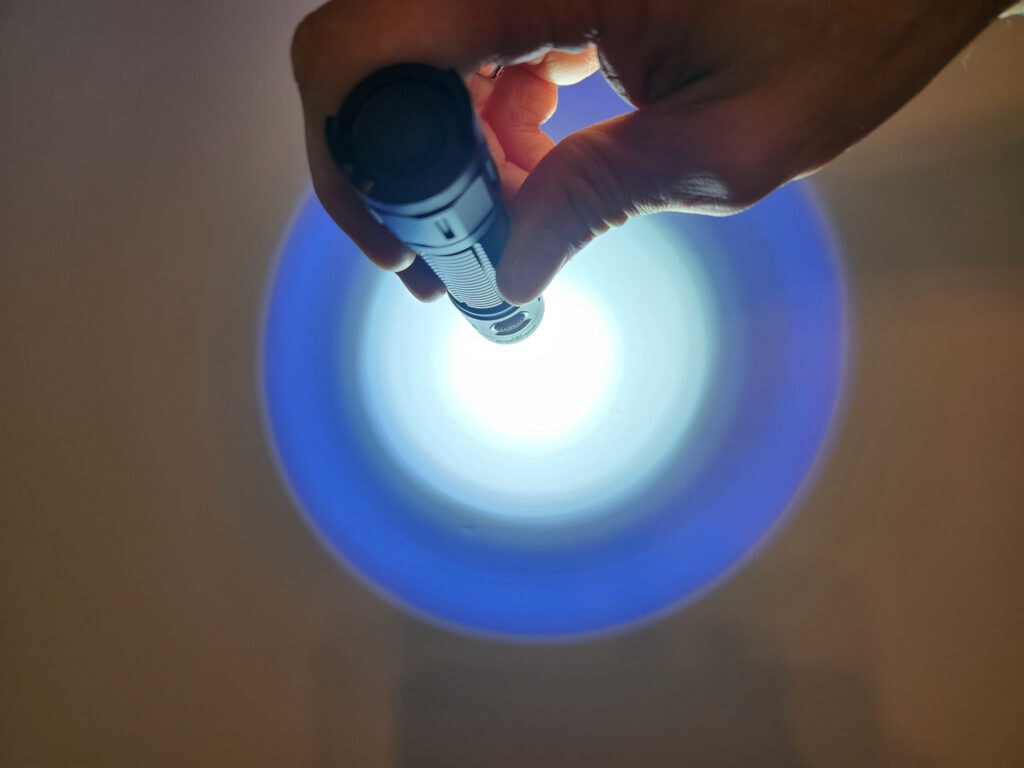
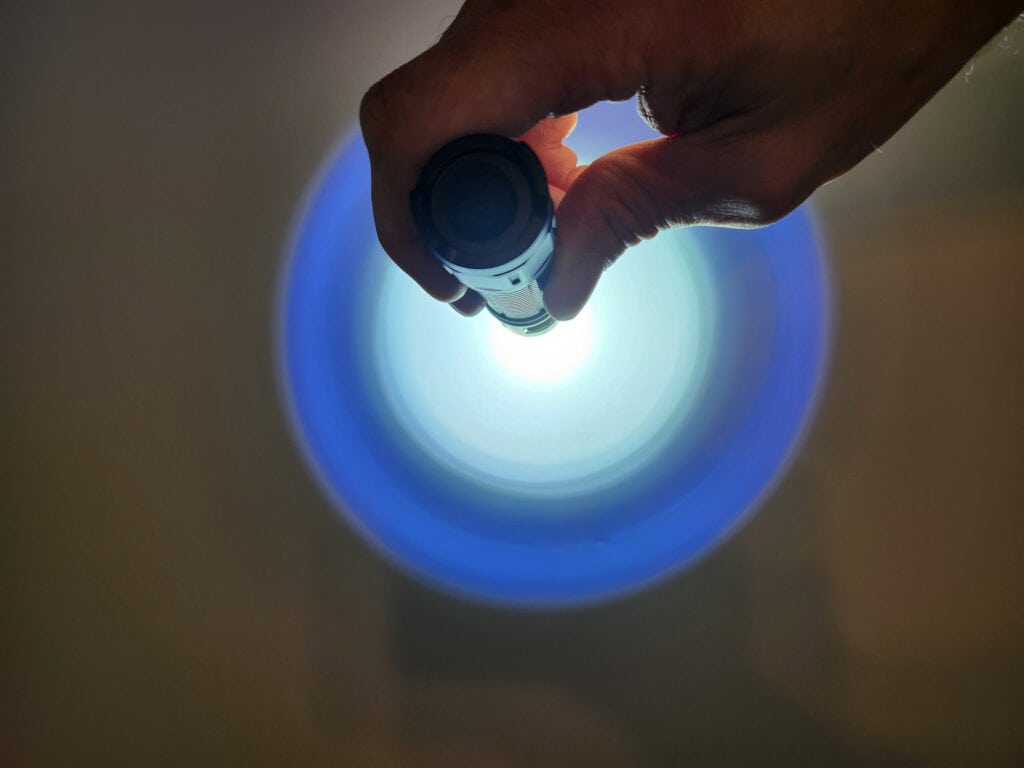
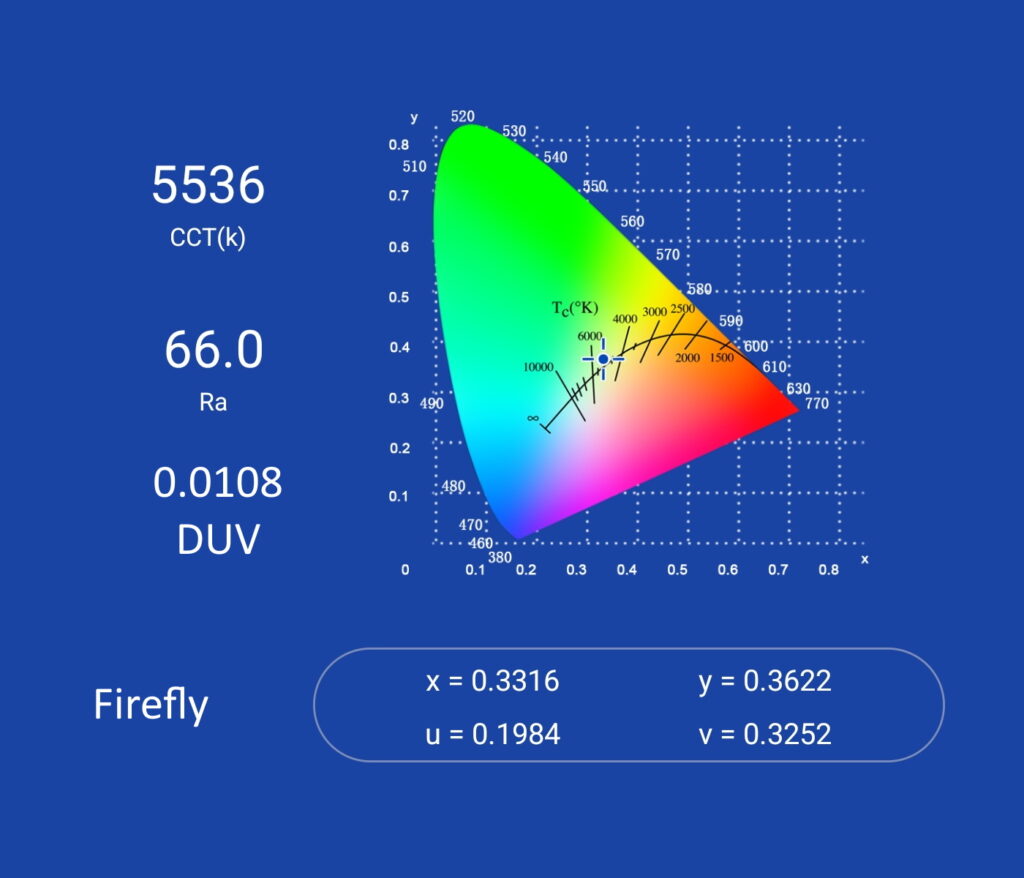
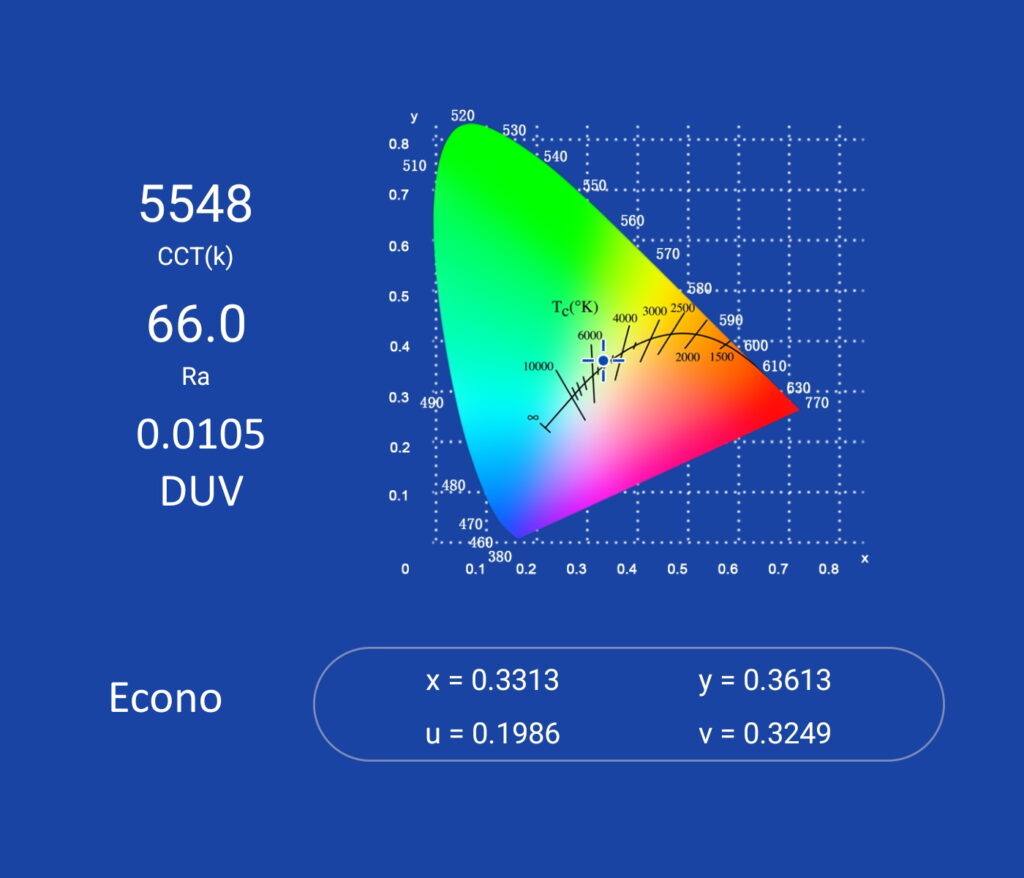
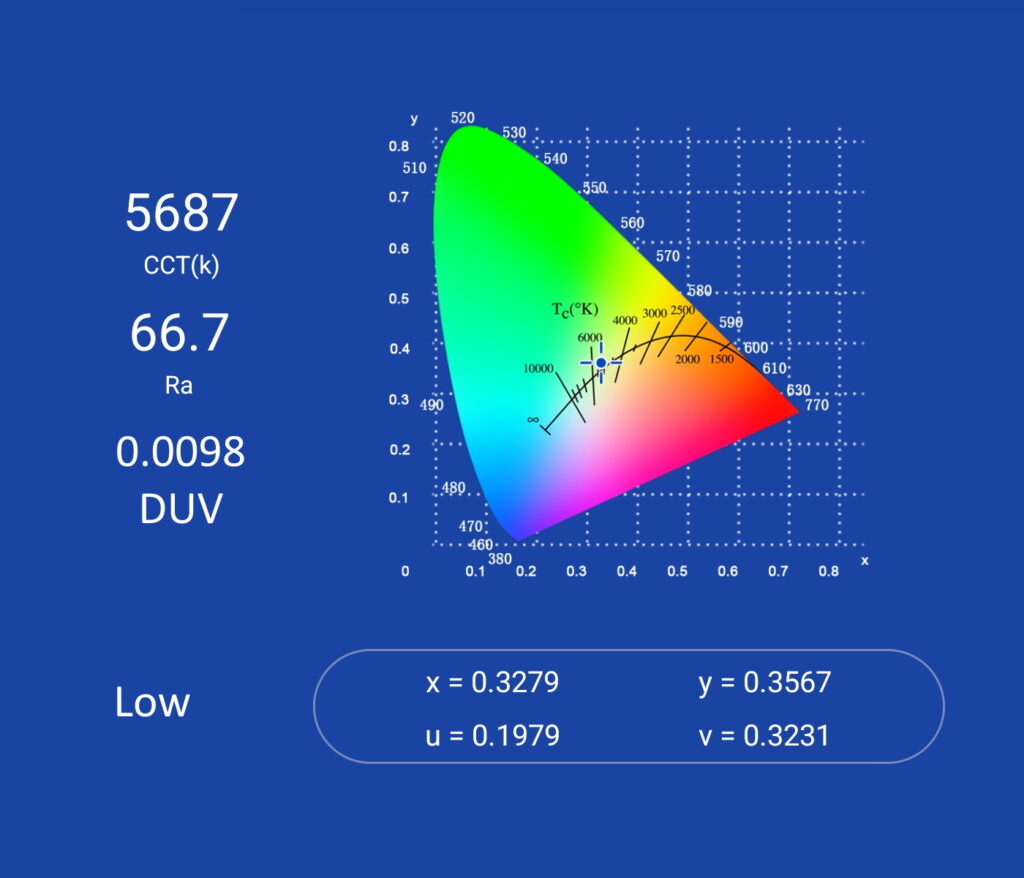
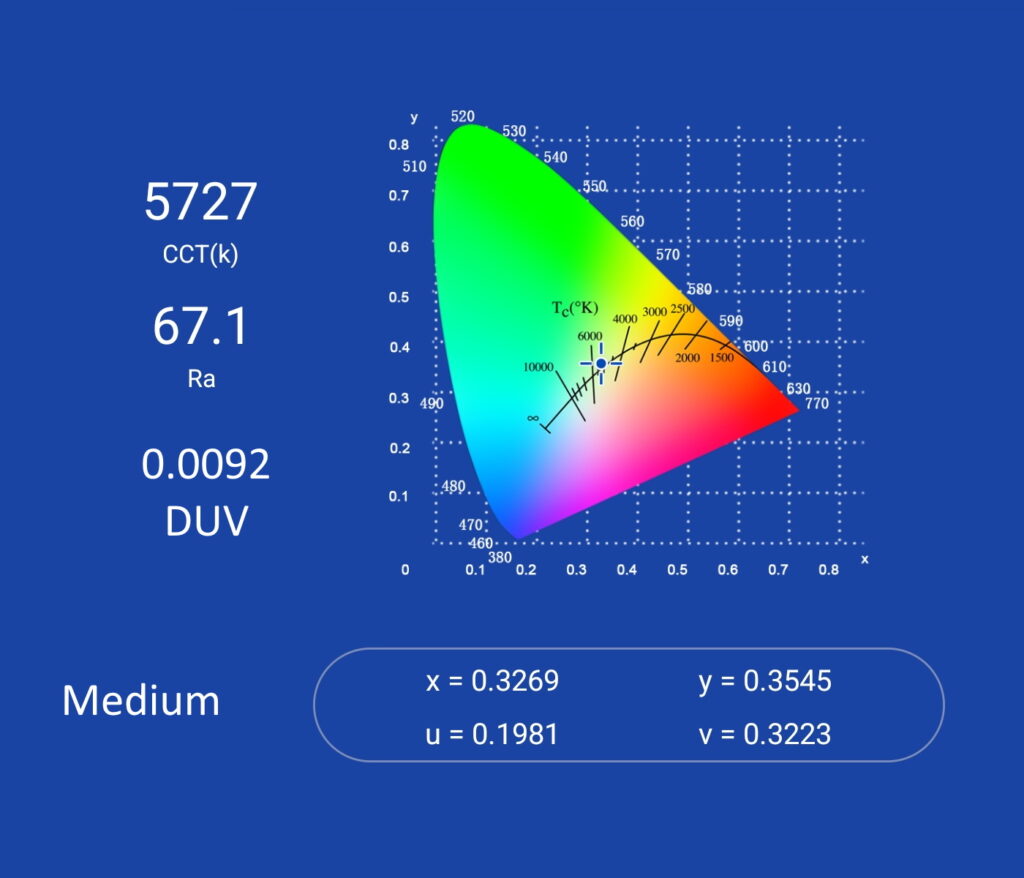
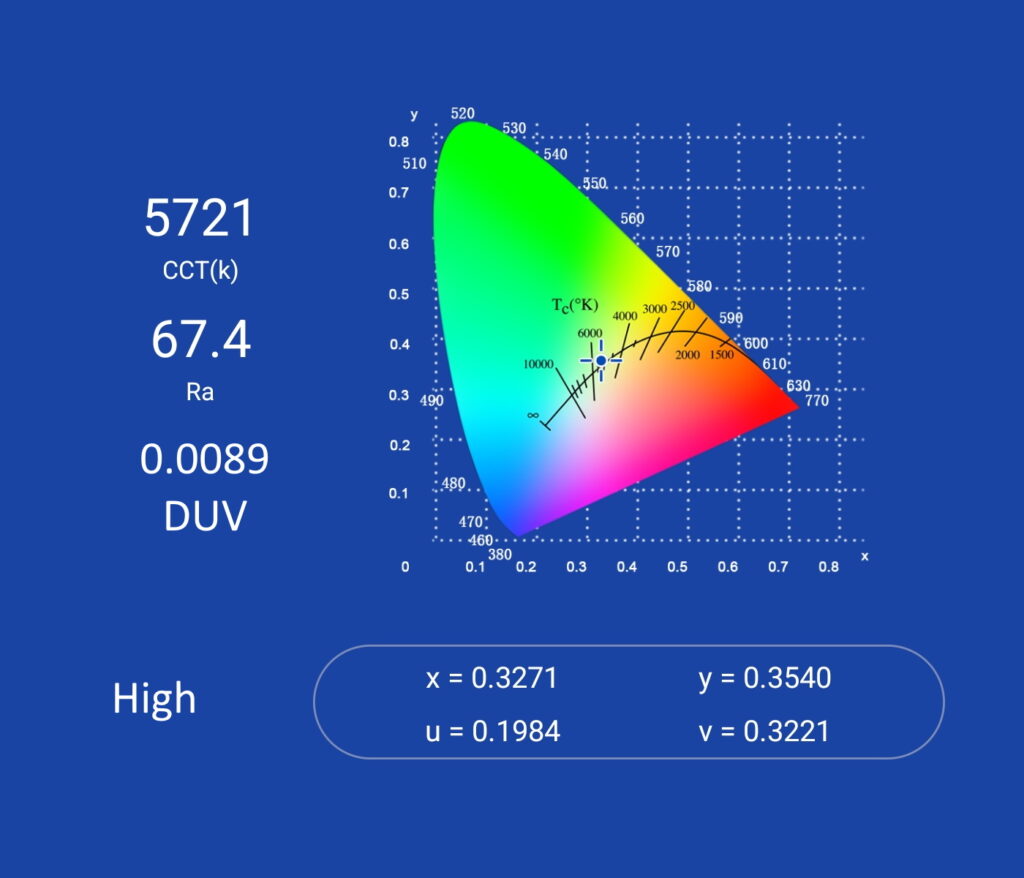

Dimensions and size comparison
Dimensions:
| Dimension | Millimeters | Inches |
|---|---|---|
| Length | 128.8 | 5.07 |
| Head diameter | 26.0 | 1.02 |
| Body diameter | 22.9 | 0.9 |
Weight:
| Weight | Grams | Oz. |
|---|---|---|
| Without battery: | 75 | 2.6 |
| With battery | 121 | 4.3 |
Flashlight size comparison with its competition
Group 1: Mijomi J81, ThruNite TN12 Pro, Acebeam E70
Group 2: Mijomi J81, Convoy S2+, Emisar D4V2

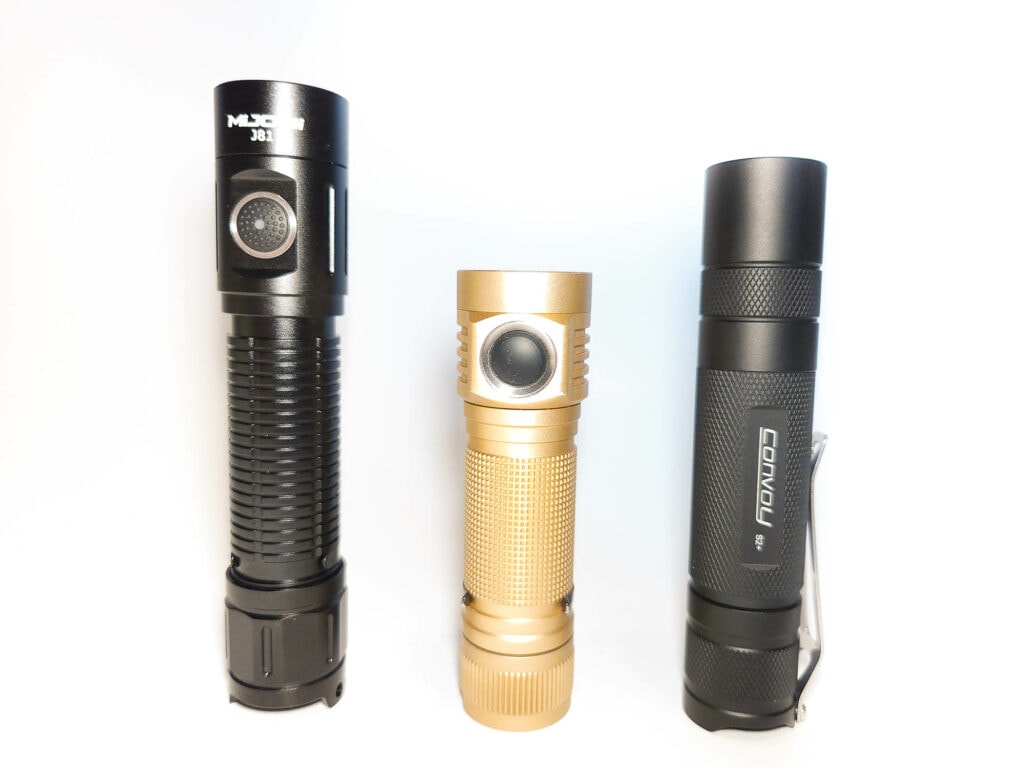
Driver & User Interface:
Available modes: 5 levels. They’re referred to as firefly, econo, low, medium, and high.
Available blinky modes: Strobe, “SOS”
User interface:
From OFF:
- Side Switch: Nothing
- Tail Switch:
- Half press: Momentary memorized mode
- Click: On
From ON:
- Side Switch:
- Click: Mode advance
- Hold: Switch to strobe group
- Tail Switch:
- Click: Off
Mode memory:
- ALL modes are memorized, including strobe and SOS
Shortcuts:
- None
Low voltage warning:
- The light will blink and step down.
Strobe/blinkies
- From on:
- Hold: Strobe:
- From Strobe:
- Click: SOS
- From SOS:
- Click: Low
- From SOS:
- Click: SOS
Lock-out mode:
- There is no electronic lock out mode, but since the threads are anodized, you can loosen the tail cap for mechanical lock out.
PWM
- The Mijomi J81 does not have PWM at all.
Additional info on the UI: “SOS” doesn’t actually spell out SOS in Morse code. Instead of …—… it blinks out —..—.. repeating without any breaks. That would be the letters “oi” (— ..) which I guess would still be an attention getter, or the number 8 (—..) which might just confuse any potential rescuers, as “88” (—.. —..) is apparently Morse shorthand for “love and kisses.”
Batteries & Charging
Mijomi added USB C charging to the J81, which works with the included USB A to C cable. I was unable to test USB C to C because the plastic surrounding the plug on my C to C cable was too wide to fit into the recessed area of the head where the charging port was. Also included is an unbranded, protected, button top 18650 battery with 2600mAh capacity. In fact, when I did a 250mA capacity test on the battery with my Vapcell S4+ charger, it came out to be exactly 2600mAh.
Low voltage protection on the battery kicked in at 2.87V during my testing, which is a decent level. I was able to get it below that by repeatedly turning the light on after it shut off, though once it stepped down, it would not go back up to levels higher than that. I charged the battery using the onboard USB C charging and it took an average of 3 hours and 38 minutes to charge fully, and the final voltage came out to be an average of 4.17V, which is also a decent level. During charging, the indicator light in the side switch is red, and when it’s complete, it turns green.
Mijomi mentions the J81 can take two CR123A batteries instead of an 18650, but not two 16340s or RCR123s. I did not have CR123As to test with, so I’ll leave it at that. Obviously, CR123As are not rechargeable in any way, shape, or form.
As mentioned before, a flat top, unprotected battery will fit, though not necessarily compress the springs on either end enough to prevent it from disconnecting when struck.
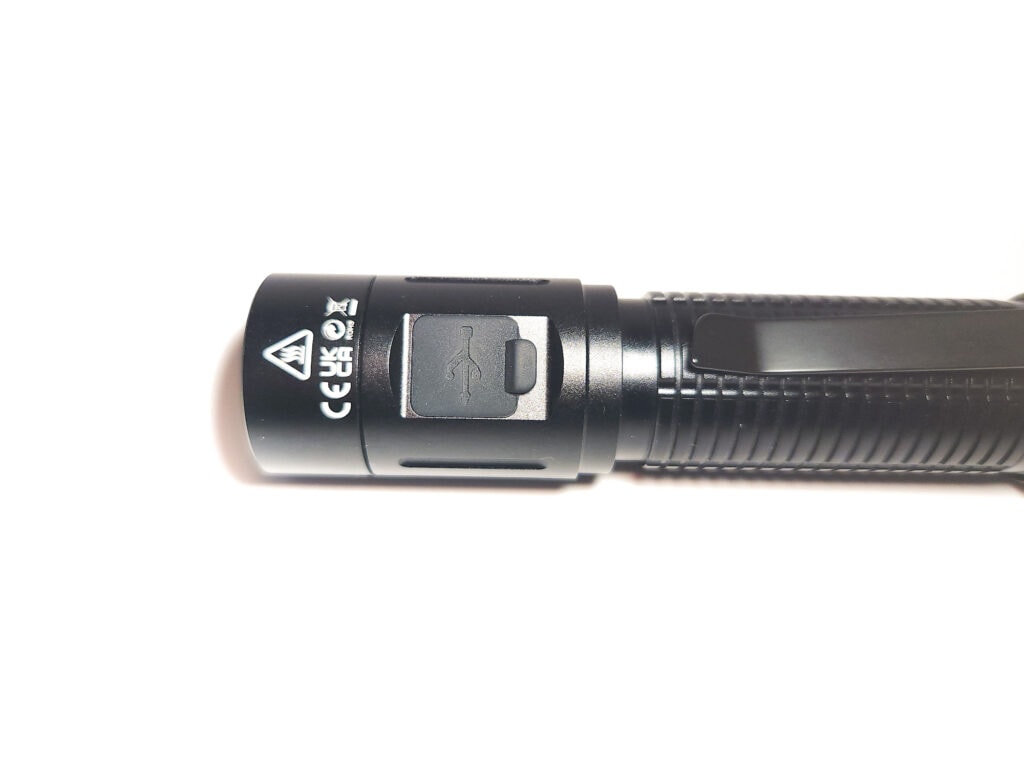
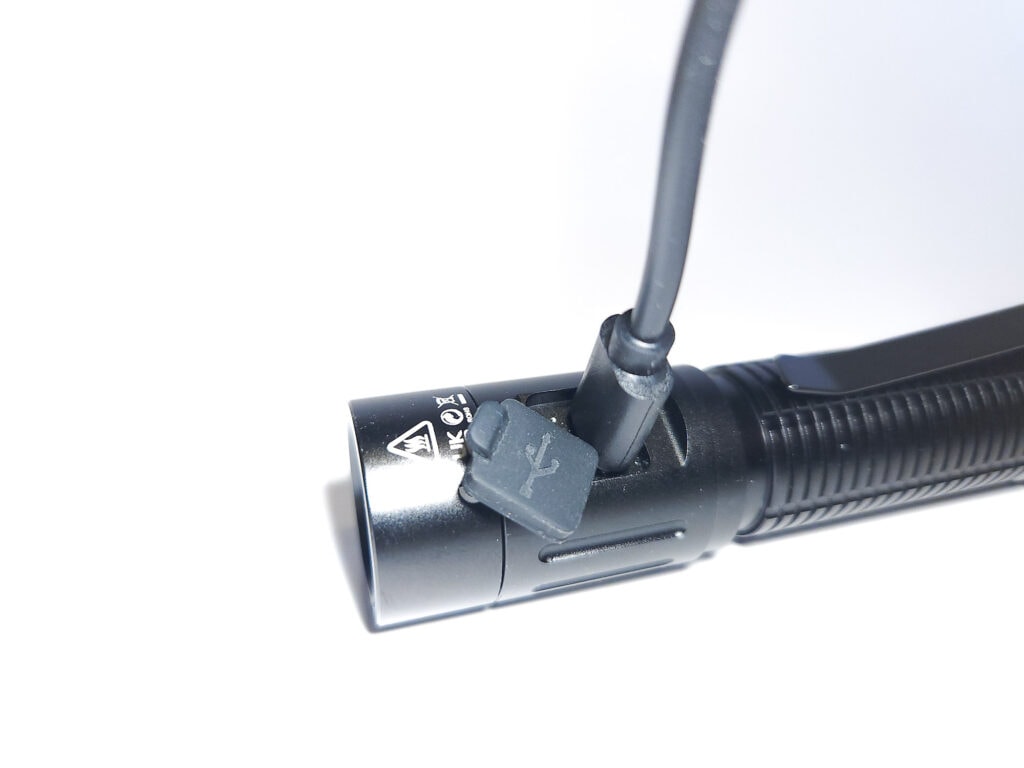
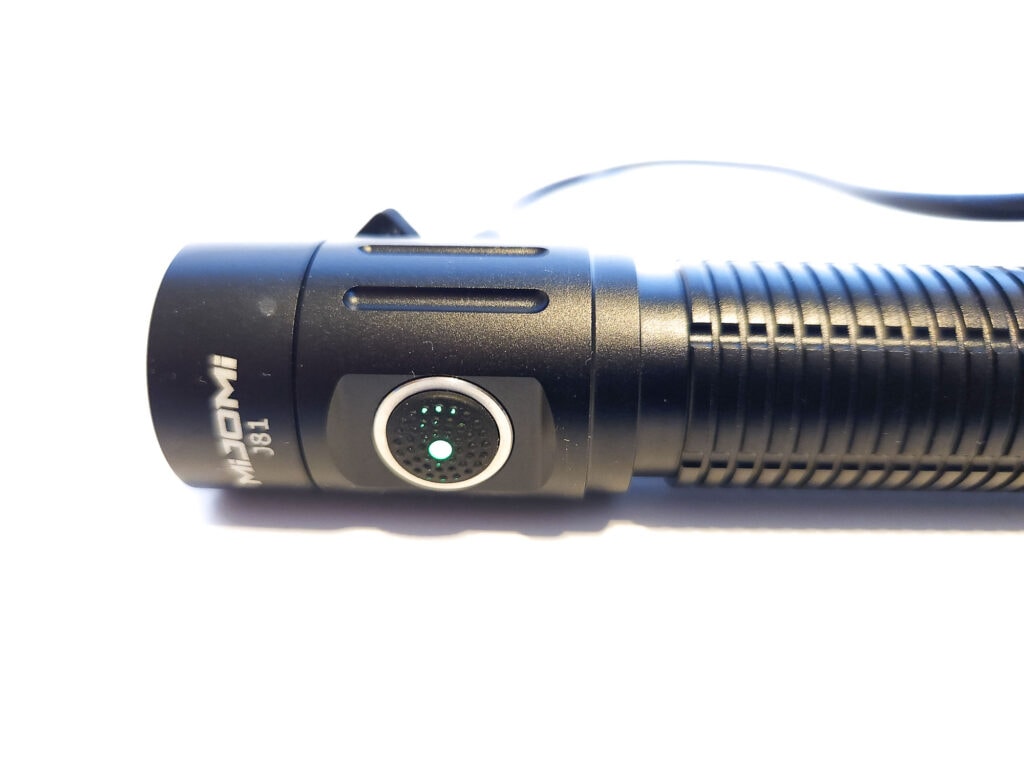
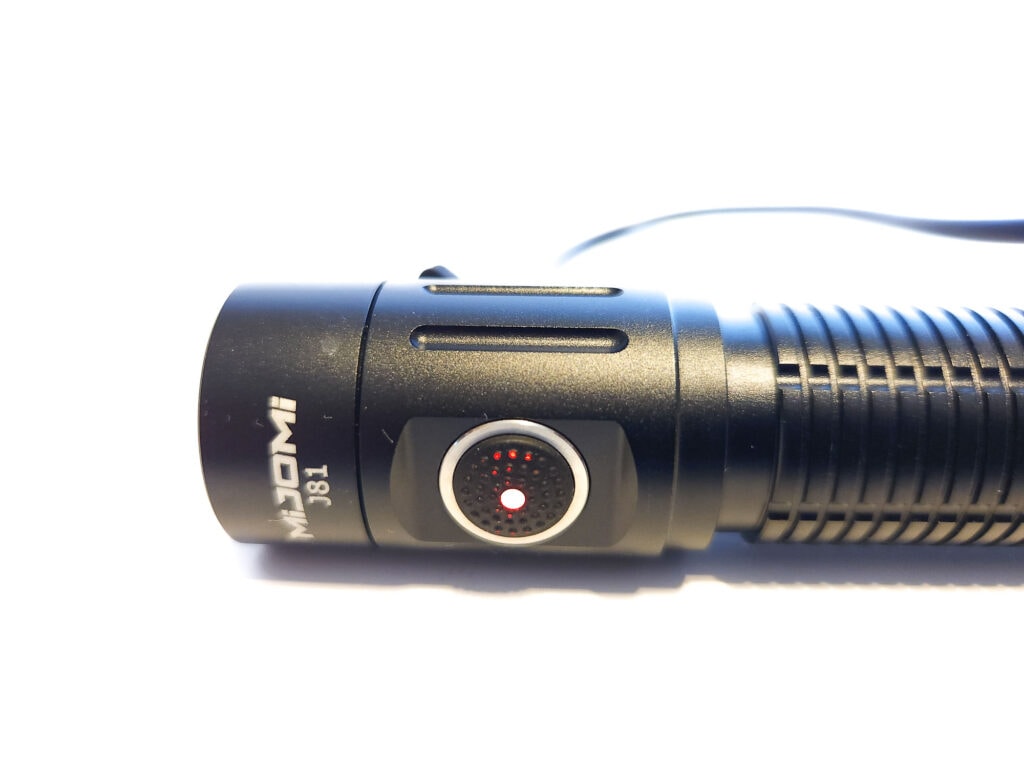
Performance test
To obtain these numbers, I used a very rudimentary integrated shoebox and ceilingbounce on my Samsung Galaxy S10. Ceilingbounce has been calibrated to match the specs of the Baton 3 as provided by Olight and corroborated with other reviewers.
Lumen measurements
I was surprised to see regulated output on this light, given that it’s a budget light and not from a name brand. It’s also nice that the modes almost step down onto each other, with high dropping to almost medium level, then both high and medium dropping to low.
Another thing that was somewhat surprising is that eco, low, and medium all exceeded specs and high came pretty close. It’s not often that happens. Runtime was similar: All measured modes exceeded specs; high by quite a bit. Definitely a feather in the J81’s cap.
| Mode | Amps at start | Specs | Lumens @turn on | Lumens @30 sec | Lumens @10 minutes |
| Firefly | 0.01 | 1 | 0 | 0 | 0 |
| Econo | 0.17 | 50 | 66 | 69 | 68 |
| Low | 0.45 | 150 | 182 | 175 | 173 |
| Medium | 1.16 | 400 | 460 | 457 | 450 |
| High | 1.38 | 1300 | 1111 | 1091 lm | 470 |
(Edit: Nov 2022: lumen table updated after applying new correction factor)
Parasitic drain:
- None, due to the electronic side switch only being enabled when light is on.
Battery Life: Runtime graphs
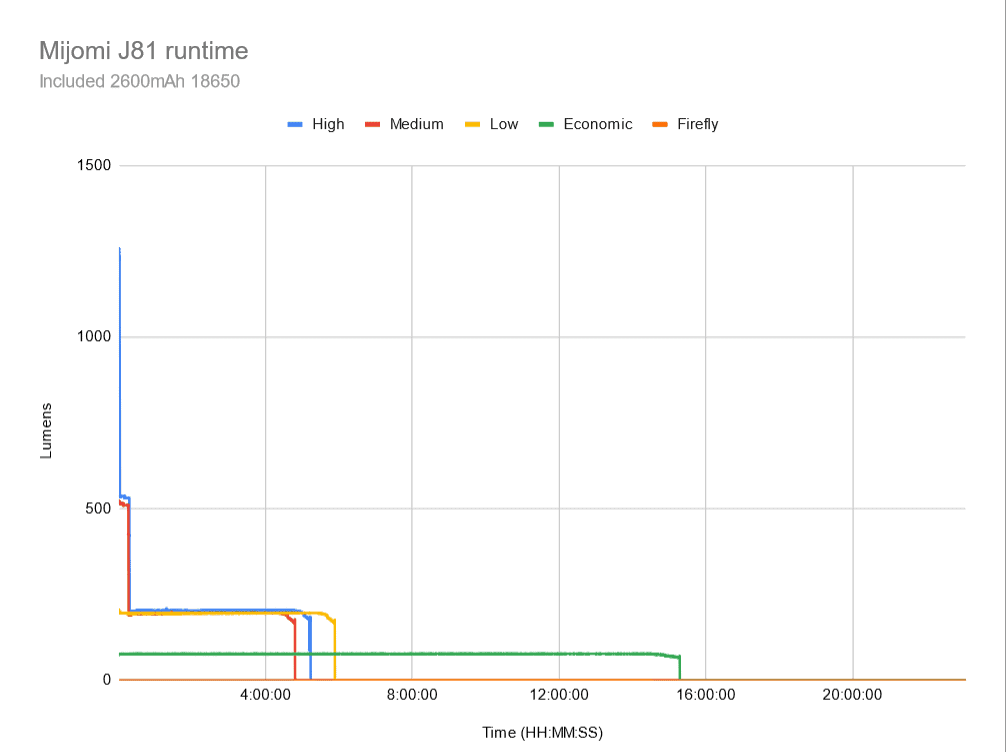
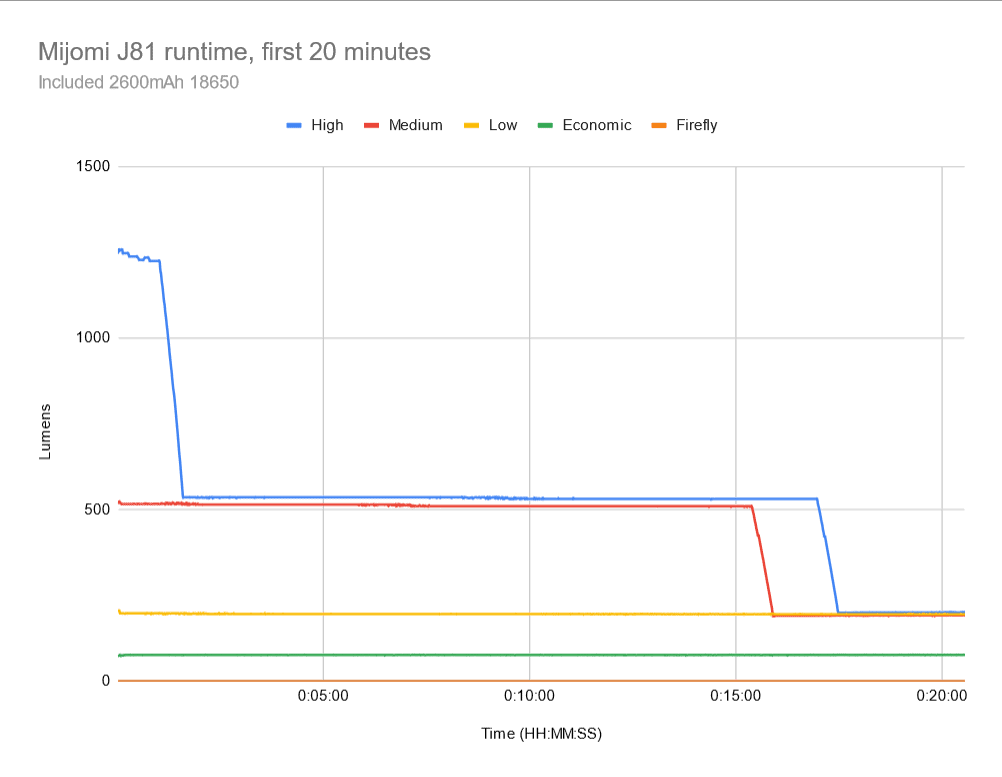
| Mode | Specified | Measured runtime (ANSI) | Time till shut off |
|---|---|---|---|
| Firefly | 480h | – | – |
| Econo | 15h | 15h 17min | 23h05min |
| Low | 5h | 5h 53min | * |
| Medium | 4h | 4h 48min | * |
| High | 3h | 5h 13min | * |
I usually run my runtime tests overnight since they take so long. However, in this situation, all modes eventually dropped to firefly levels, which read out as 0.0 lumens in ceilingbounce. The problem with that is that I do not know exactly when the light shut off for most modes. Econo was the only one I was able to watch turn off, since it lasted so long. From that data, we can extrapolate that you will still be able to use sub-lumen firefly mode for a good long time after output drops off.
ANSI FL1 standards: The runtime is measured until the light drops to 10% of its initial output (30 seconds after turning on). This does not mean that the flashlight is not usable anymore. The last column shows how long the light actually works till it shuts off. If there is a + symbol, it means that the test was stopped at that particular point, but the light was actually still running. This happens on certain occasions, with certain drivers, firmware, or batteries.
Peak beam intensity and beam distance measurements
The numbers for candela were obtained with a UNI-T UT383S luxmeter at 5 and 15 meters at 30 seconds, then averaged.
The only number Mijomi gives for intensity or throw is that it will hit 200 meters. Surprisingly, it does just that with high coming in at 202 meters after 30 seconds of runtime.
| Mode | Specs | Candela measured | Meters | Yards |
|---|---|---|---|---|
| Firefly | – | – | – | – |
| Econo | – | 600 | 49 | 54 |
| Low | – | 1538 | 78 | 85 |
| Medium | – | 4350 | 132 | 144 |
| High | 200m | 10,250 cd | 202 m | 221 y |
Extra info: Peak beam distance according to ANSI FL1 standards: The calculated value of distance in meters at which the flashlight produces a light intensity of 0.25 lux. (0.25 lux is about the brightness of a full moon shining on an object).
Beamshots
These were taken with a Samsung Galaxy S22+ using pro mode and the following settings:
- WB 5000K
- ISO 200
- Speed 0.5
Beamshots compared to the following flashlights:
- ThruNite TN12 Pro
- Lumintop GT Nano
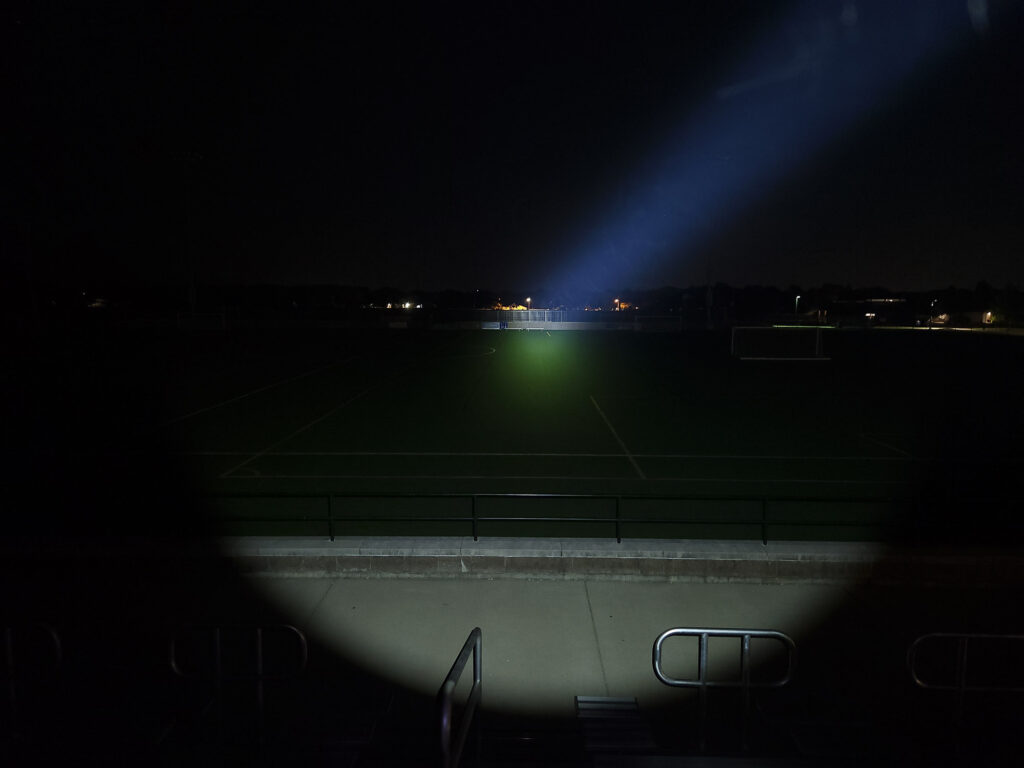
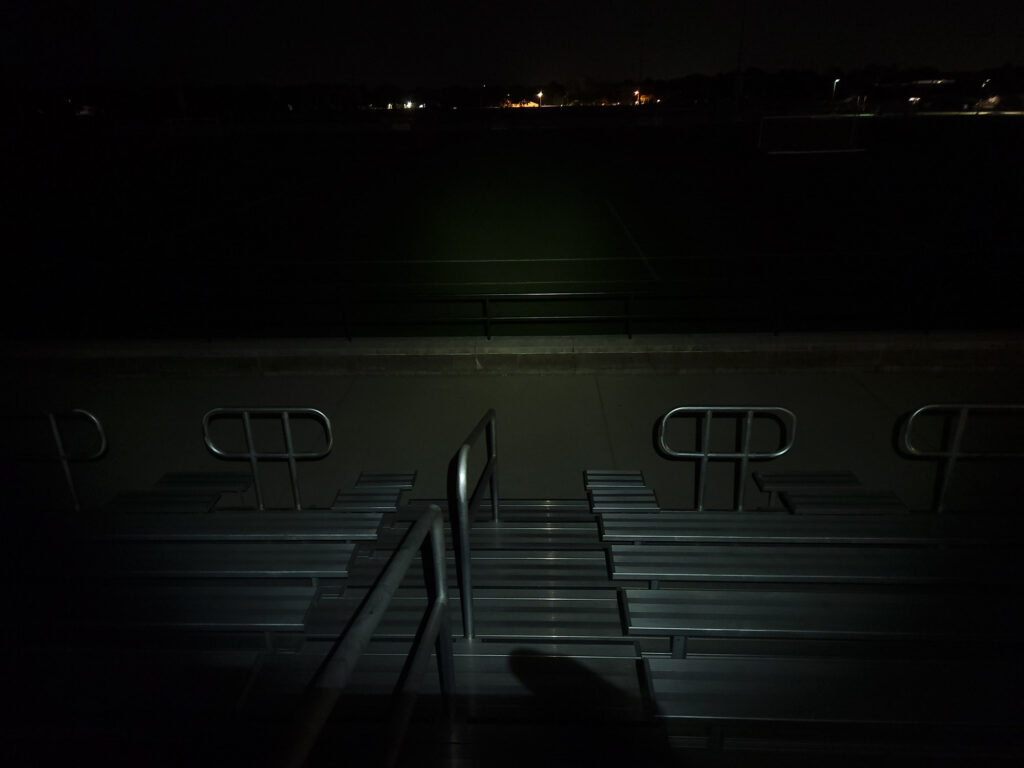
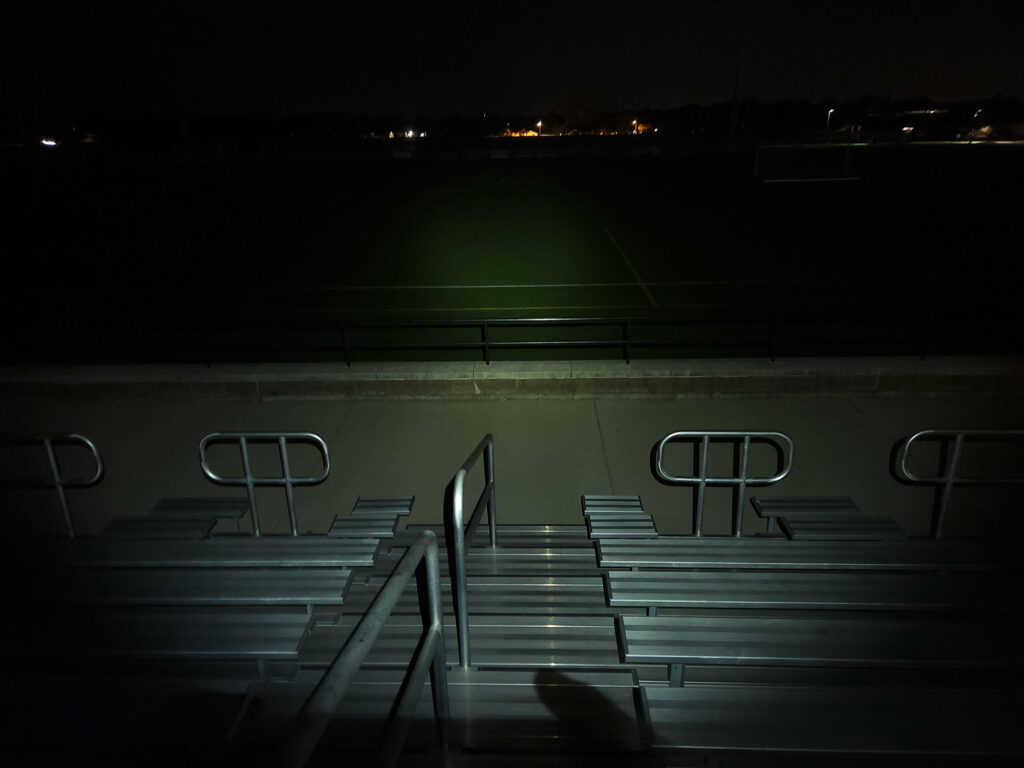
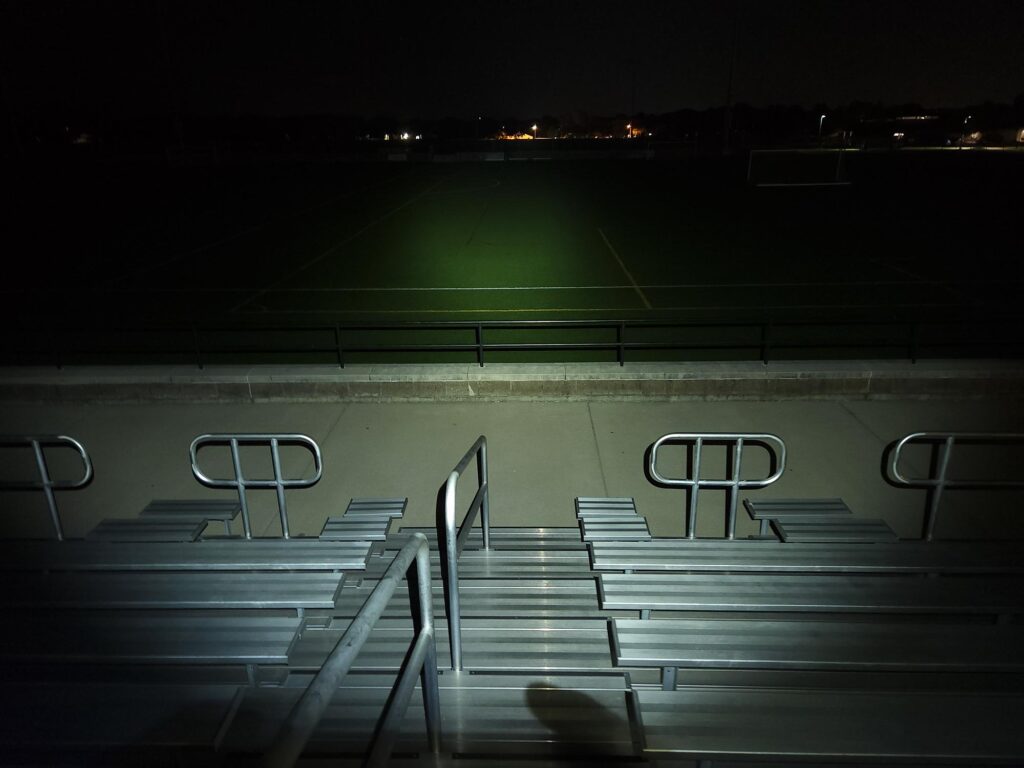
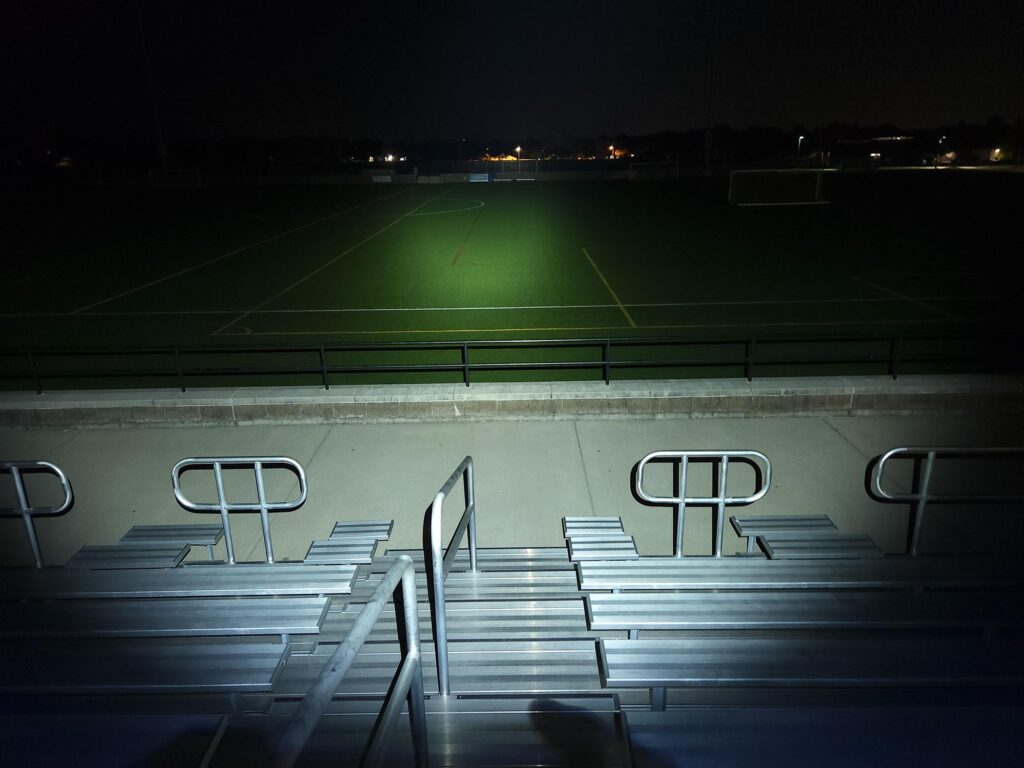
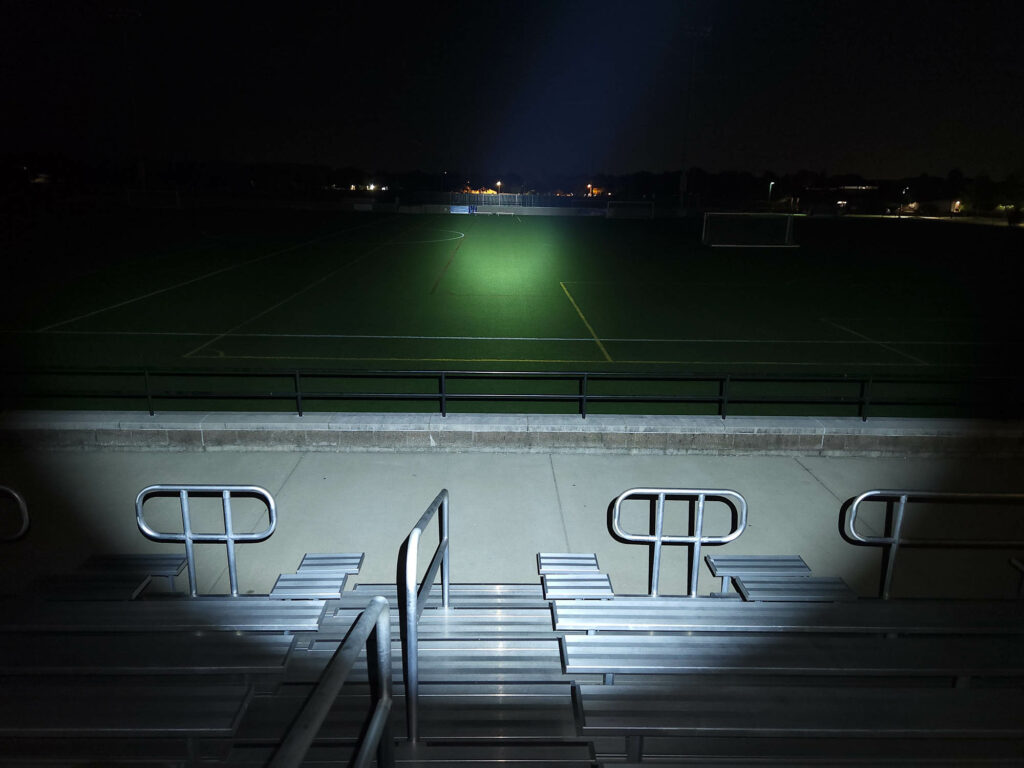
Disclaimer: This flashlight was sent to me for review at no cost by Mijoji. I have not been paid to review, nor have I been holding back on problems or defects.
Final Verdict
Pros
- Complete package; great for starting out
- USB C charging
- Regulated output
- Performed very close to specs
Cons
- Hard to switch modes one-handed
- No shortcuts to moonlight or turbo
- Tint shift
- SOS isn’t really SOS
Explanation on star ratings:
1: Avoid: a match would be a better choice – 2: Poor: significant defect or issues; almost unusable – 3: Average: some defects or issues; but still usable 4: Good: recommended (minor issues) – 5: Great: highly recommended

4 stars: ★★★★
The Mijomi J81 is a budget light, but for being a budget light, it packs a lot of features. For $20 (at the time of writing), you get a flashlight with onboard USB C charging and regulated output, as well as a battery and a full set of accessories.
The budget aspect becomes apparent when you use it: The Osram P9 doesn’t give off the nicest looking light, and the user interface lacks some common features like shortcuts to firefly and high (though at least the strobes aren’t part of the main grouping). There’s nothing functionally wrong with the light, and if you like to use one mode at a time or don’t plan on switching modes much, this basic light would work for you.
I give the Mijomi J81 a 4 star rating.
Mijomi J81 For Sale
1lumen selects and reviews products personally. We may earn affiliate commissions through our links, which help support our testing.